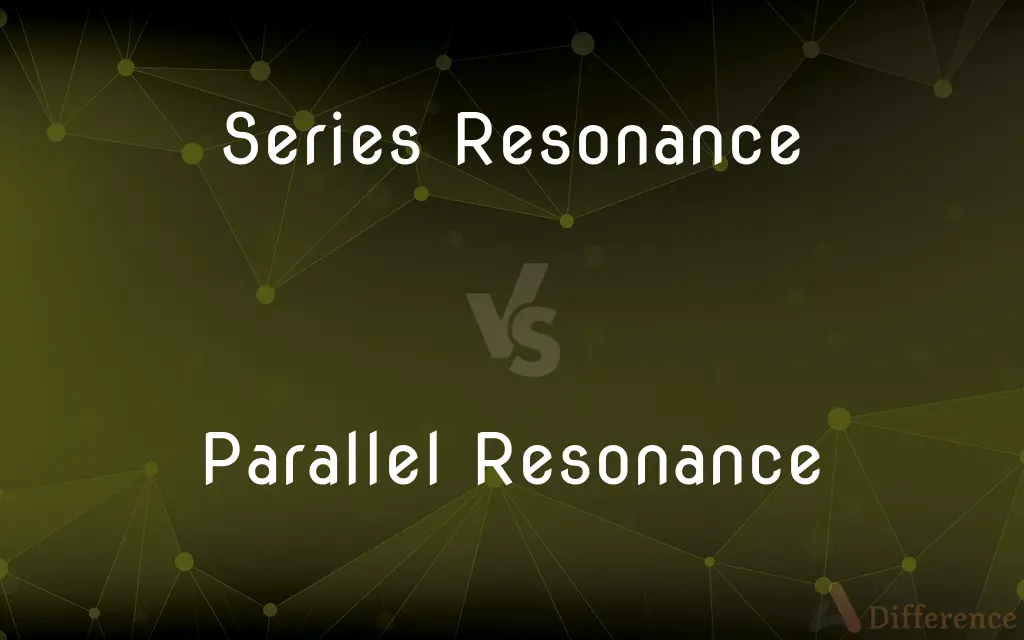Series Resonance vs. Parallel Resonance — What's the Difference?
By Tayyaba Rehman — Published on November 11, 2023
In Series Resonance, circuit components are arranged end-to-end, resulting in minimum impedance at resonance, whereas in Parallel Resonance, components are arranged side-by-side, leading to maximum impedance at resonance.

Difference Between Series Resonance and Parallel Resonance
Table of Contents
ADVERTISEMENT
Key Differences
Series Resonance and Parallel Resonance are two essential concepts in electrical circuits dealing with the resonant frequency of a circuit.
In Series Resonance, components like inductors and capacitors are connected end-to-end, or in series. When the inductive reactance equals the capacitive reactance, the circuit reaches its resonant frequency, and the impedance becomes minimal. This means the current in the circuit will be at its maximum at this frequency.
Conversely, Parallel Resonance deals with components arranged side-by-side or in parallel.
In this setup, when inductive reactance equals capacitive reactance, the impedance becomes maximum. Thus, the current at resonant frequency is minimum, a direct contrast to the series resonance scenario.
The occurrence of resonance is vital in many applications like tuning circuits, radio transmission, and filters.
ADVERTISEMENT
For Series Resonance, the sharpness of resonance is typically defined by the quality factor or Q-factor, which signifies a high selectivity. In the case of Parallel Resonance, it's used in applications where circuits need to block certain frequencies and let others pass.
Both Series and Parallel Resonance circuits have their unique response curves and behavior in the presence of alternating currents.
An understanding of both these resonance types is crucial for engineers and professionals dealing with circuit designs and applications where frequency response is pivotal.
Comparison Chart
Configuration
Components connected end-to-end
Components connected side-by-side
Impedance at Resonance
Minimum
Maximum
Current at Resonance
Maximum
Minimum
Common Use
Filters, Tuned circuits
Band-stop filters, Certain antenna systems
Behavior with Frequency
Current peaks at resonant frequency
Current dips at resonant frequency
Compare with Definitions
Series Resonance
Resonance in a series-connected inductor and capacitor.
The Series Resonance in the circuit allowed it to respond maximally to a specific frequency.
Parallel Resonance
Resonance due to equal inductive and capacitive reactance in a parallel circuit.
The circuit's Parallel Resonance rejected the 60 Hz noise effectively.
Series Resonance
A condition where impedance is minimal in a series circuit.
At Series Resonance, the circuit current reached its peak value.
Parallel Resonance
A phenomenon in parallel circuits minimizing current flow at resonance.
The Parallel Resonance in the system served as a notch filter.
Series Resonance
The specific frequency where a series circuit responds most efficiently.
The Series Resonance of the LC circuit was calibrated to 105.9 MHz.
Parallel Resonance
The specific frequency where a parallel circuit shows highest impedance.
The Parallel Resonance of the circuit was observed at 50 Hz.
Series Resonance
A phenomenon in series circuits causing maximal current flow at resonance.
The circuit's Series Resonance made it an effective band-pass filter.
Parallel Resonance
Resonance in a parallel-connected inductor and capacitor.
The Parallel Resonance condition in the circuit blocked unwanted frequencies.
Series Resonance
Resonance arising due to equal inductive and capacitive reactance in a series circuit.
The radio's tuner achieved Series Resonance at 98.7 MHz.
Parallel Resonance
A condition where impedance is maximal in a parallel circuit.
At Parallel Resonance, the circuit current was notably reduced.
Common Curiosities
What's the main difference between Series and Parallel Resonance?
In Series Resonance, impedance is minimal, and current is maximal at resonance, while in Parallel Resonance, it's the opposite.
Which resonance type is used in radio tuning circuits?
Series Resonance is commonly used in radio tuning circuits.
Can Parallel Resonance be used for filtering applications?
Yes, Parallel Resonance can function as a band-stop or notch filter.
What happens to impedance in a series circuit at resonance?
In Series Resonance, the impedance becomes minimal.
Why is Series Resonance important in antennas?
Series Resonance allows antennas to be tuned to specific frequencies, enhancing their transmission or reception capabilities.
Which resonance type has a sharp response curve?
Series Resonance typically has a sharper response curve, especially with a high Q-factor.
Is quality factor applicable to both resonance types?
While Q-factor is more commonly associated with Series Resonance, it can be applied to Parallel Resonance too, albeit with a different interpretation.
Can resonant circuits be used in power systems?
Yes, both Series and Parallel Resonant circuits find applications in power systems, often for filtering purposes.
Which resonance can effectively block specific frequencies?
Parallel Resonance can act as a notch filter to block specific frequencies.
Which resonance type has a dip in the current response at resonance?
Parallel Resonance shows a dip in current response at resonant frequency.
Can resonance conditions change over time?
Yes, component aging or environmental factors can shift the resonant frequency.
Are resonant circuits used in audio systems?
Yes, both Series and Parallel Resonant circuits are used in audio systems for tuning and filtering purposes.
What's the role of capacitors in resonant circuits?
Capacitors, along with inductors, determine the resonant frequency and type of resonance in a circuit.
Can circuit components impact the type of resonance?
Yes, the arrangement (series or parallel) and values of components like inductors and capacitors determine the resonance type and its frequency.
Why is impedance important in resonant circuits?
Impedance affects the current flow and power dissipation, making it crucial in determining the circuit's behavior at resonance.
Share Your Discovery

Previous Comparison
Gelato vs. Ice Cream
Next Comparison
Fiber vs. ProbioticsAuthor Spotlight
Written by
Tayyaba RehmanTayyaba Rehman is a distinguished writer, currently serving as a primary contributor to askdifference.com. As a researcher in semantics and etymology, Tayyaba's passion for the complexity of languages and their distinctions has found a perfect home on the platform. Tayyaba delves into the intricacies of language, distinguishing between commonly confused words and phrases, thereby providing clarity for readers worldwide.











































